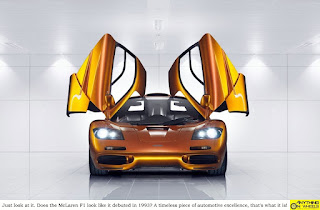The quintessential sports car of the nineties, the former "world's fastest production car" record holder, the default poster car for a whole generation of auto enthusiasts, 'the ultimate' sports car for legions of purists, the McLaren F1, turns 25 today.
It was on this day in 1992 McLaren took the wraps off what would become one of the most iconic sports cars to have ever graced the planet. Be it the one-of-a-kind 1+2 seating layout, the legendary performance from the naturally aspirated V12 or the stunning looks characterized by the distinct dihedral doors, the McLaren F1 was, and still is, a masterpiece in automotive engineering.
Conceived over an airport conversation during McLaren’s all-conquering and record-shattering 1988 Formula One season with Ron Dennis at the helm, the F1 was designed and built with an all-out ‘no compromise’ approach.
Four years in the making, the McLaren F1 debuted as an exceptionally quick sports car in 1992 that ended up breaking numerous speed records throughout the nineties. On the 31st of March, 1998, Andy Wallace reached a speed of 386.47 km/h (240.14 mph) piloting a McLaren F1, making it the fastest production car of the time. While that title subsequently changed hands, the McLaren F1 is still the fastest naturally aspirated road car ever built. Damn, who needs those turbos and superchargers?
The BMW-sourced 6.1-liter V12 powering the F1 delivered in excess of 620 horsepower, unheard of from a powerplant of that size. All those horses naturally generate a lot of heat and to dissipate that, McLaren used pure gold, the best heat reflector available!
That's not all. The McLaren F1 was the first production car ever to have a carbon fiber chassis that was lighter yet stronger. The throttle pedal was handcrafted with titanium, the instrument panels were hand-made and hand-painted and the needles were individually machined. Would you believe us if we tell you that even the tool kit in F1 was made of titanium making it 50% lighter than a steel kit?
A direct result of McLaren’s supremacy in Formula One is that a whole lot of tech from the world’s most premier racing series trickled on to the road through F1. The onboard diagnostic computer, for instance, continuously monitors and logs a host of performance factors to identify and diagnose faults. Computer-controlled Airbrake meant that the car could shed speed as quickly as it gained.
Just 106 of these were made, making the F1 a super exclusive sports car.
A spiritual successor to the F1, a Hyper GT as McLaren refers to it, is currently under works with the codename BP23. Just like the F1, only 106 of them would be made and each one of those have been reportedly spoken for already. While no other details are out yet, the teaser pic released by McLaren showing off the car's F1-like 1+2 seating layout has sent the expectations sky high. Nothing less than an insane hyper car that betters the F1 in every little respect would now satisfy us.
Coming back to the F1, McLaren would be celebrating the car's 25th anniversary all through the year by sharing 'not-known-before' snippets and anecdotes every month. 2017 sure is gonna be interesting. Stay tuned!





No comments:
Post a Comment